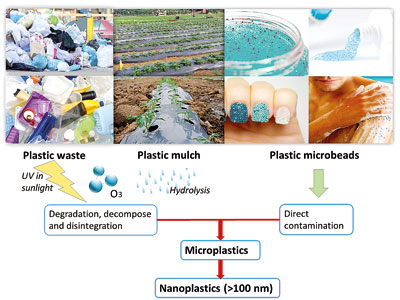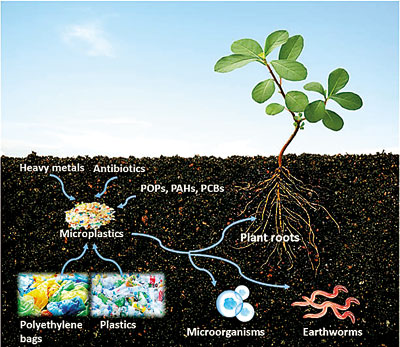The fate of microplastics in soil

Plastics are synthetic organic polymers with high molecular masses, which are derived from petrochemicals. Bakelite is the world’s first synthetic polymer, which is made from phenol and formaldehyde, by a Belgian-born American, Leo Hendrik Baekeland in 1907. The low cost, easy manufacture, user-friendly, and versatile properties of plastics have achieved rapid popularity worldwide. Most of the traditional materials, such as wood, glass, and metal, were substituted with plastic, including household materials and other materials.
However, due to the prolonged degradation of plastics, it is possible to exist for over a hundred or maybe a thousand years and accumulate in the environment. More than 32% of all plastic production is environmentally available according to experimental data. Environmental pollution by plastics does not limit only to slow degradation. The micro-scale plastic particles from the weathering process of plastics, as well as from man-made products such as cosmetics, can be more harmful to both human and the ecosystem. These microscale plastics particles are known as “microplastics,” which has gained recent global attention. In 2004, Professor Richard Thompson from the UK had introduced the term “microplastics” and the plastic fragments, which is less than 5 mm in size, is known as microplastics.
Microplastics can be classified into two main groups, primary microplastics, for instance, microfibers, microbeads, and plastic pellets, which discharges from personal care products, synthetic fabrics, and various industries. Secondary microplastics generates due to the degradation of larger plastic products under the natural weathering process. Ultra violet radiation in sunlight is one of the governing factors in plastic film degradation, which is known as photoinduced degradation. Other degradation pathways for microplastic degradation, decomposition and disintegration are through hydrolysis; rainwater, ozonolysis; and oxidation. Most of the studies on microplastics have focused on assessing the effects on aquatic environments, while a limited number of studies have been conducted on the effects on soils. Scientists have estimated that soils might store more microplastics rather than aquatic environments. Anthropogenic activities such as plastic mulches in agriculture, contaminated water sources from household and industrial effluents, and application of compost from municipal solid waste, may contaminate the soils with microplastics.
The method of contamination of microplastics in the soil can vary from place to place. Other than the microbeads from personal care products, the possible contamination pathways are plastic mulches in agricultural lands and municipal solid waste compost. In Sri Lanka, most of the microplastics pollution is triggered by the application of commercially available compost. Due to inadequate segregation of waste, organic municipal solid waste has been contaminated with plastics. In the compost degradation process, these plastics also can be degraded to microplastics and pollute the final product. Sri Lankan farmers utilize compost in organic farming as well as in general cultivation, mixing up with fertilizers. Other than the agricultural lands, homesteads also have applied compost to boost the growth of plants. Therefore, microplastics in compost can contaminate the soil in various means.

Plastic mulches are degradable polyethylene covers, which is used to cover the surface soil to protect water from evaporation, soil erosion, and suppress the growth of weeds. Although plastic mulches are very famous in foreign countries, it is not much popular in Sri Lanka. Upland farmers use these plastic mulches to control soil erosion in incline lands. However, with the time, degradation of polyethylene sheets releases microplastics directly to the soil, and the pollution of microplastics can be larger than the application of contaminated compost.
Scientists have investigated the effects of microplastics on soil and found out the adverse effect on the physical, chemical, and biological properties of soils. Microplastics can act as a vector, which can adsorb substances, transport to a different place, and then desorb. Organic pollutants (e. g. persistent organic pollutants (POPs), polycyclic aromatic hydrocarbons (PAHs), polychlorinated biphenyls (PCBs), pesticides and herbicides), and pharmaceuticals such as antibiotics are common pollutants, which has a better affinity to bind on microplastics. Although there is not much affinity to inorganic heavy metals such as mercury, lead, cadmium, these metals can be bound by weak bonds, transport, and release at a different location due to a slight change in pH in the media. Therefore, a direct influence on soil chemistry is observed, and soil can make complexes, especially with organic pollutants. Furthermore, heavy metals accumulation in the soil can affect the soil resident animals, while antibiotics attached to microplastics in natural environments can develop antibiotic-resistant bacteria.
Soil biota plays a vital role in soil ecosystem, agriculture, and plant growth. Soil biota includes the micro-organisms (bacteria, fungi, archaea, and algae), soil animals (protozoa, nematodes, mites, springtails, spiders, insects, and earthworms) and plants. The decomposition of organic matter by soil organisms has an immense influence on soil fertility, plant growth, soil structure, and carbon storage. Studies have reported that microplastics can harm the earthworm’s intestinal tract and cause death. Other than earthworms, microplastic is harmful to filter feeders, including ciliates and flagellates. Microplastics can directly influence the vital relationship between soil and water, soil structure, and microbial function. In 2018, the same German research group had conducted the first explorative data-driven analysis of microplastic impacts on soil function. They have used Polyester, polyacrylic, and polyethylene, which are some of the commonly found microplastics in the soil to assess the biophysical environment of soil. From the overall results of the research, it was clear that microplastics directly influence the physical properties of soil by decreasing the soil bulk density, water-stable soil aggregates, and water holding capacity.
Not only soil organisms, but also plant systems may have influences from microplastics. In 2019 a research group from Germany had studied the performance of spring onion plants (Allium fistulosum) with the most common types of microplastics. The study revealed significant changes in plant biomasses, elemental tissue composition, and root traits with the presence of microplastic in the soil. Other than the type of the microplastic particle, the shape also affects the performance of the plant. Particles which has a similar shape to natural soil particles demonstrates minimal differences in the behaviour of plant, while different shapes demonstrated substantial differences. Some studies have shown an increase in plant growth at the presence of microplastics however, scientists seem reluctant to state that the microplastics increase overall growth performance of plants as no adequate research done to conclude. Plant growth effects may govern by types of microplastics, their characteristics, size, and plant species. Even if the plant growth increases pervasive effects may be present for the plant performance and ecosystem biodiversity.
These anthropogenic adulterants pollute to the terrestrial ecosystem. Finally, the adverse effects of soil pollution by microplastics influence soil fertility, crop production, food security, as well as human health. Therefore, the general public should be educated more about microplastics, how can it contaminate soil, and how to protect soil from microplastic contamination. Nevertheless, scientists should conduct more research studies to understand the fate of soil microplastics and their implications on soil organisms. Since plastic recycling is not performing well in Sri Lanka, it is our responsibility to reduce the utilization of plastic and polyethylene products as much as possible. Furthermore, the government of Sri Lanka can bring up the necessary rules and regulations to discourage the production and import, personal care products which are rich in primary microplastics. As an agricultural-based country, it is essential to pay attention on keeping soil fertility, health, and condition appropriate for sustainable agriculture.


